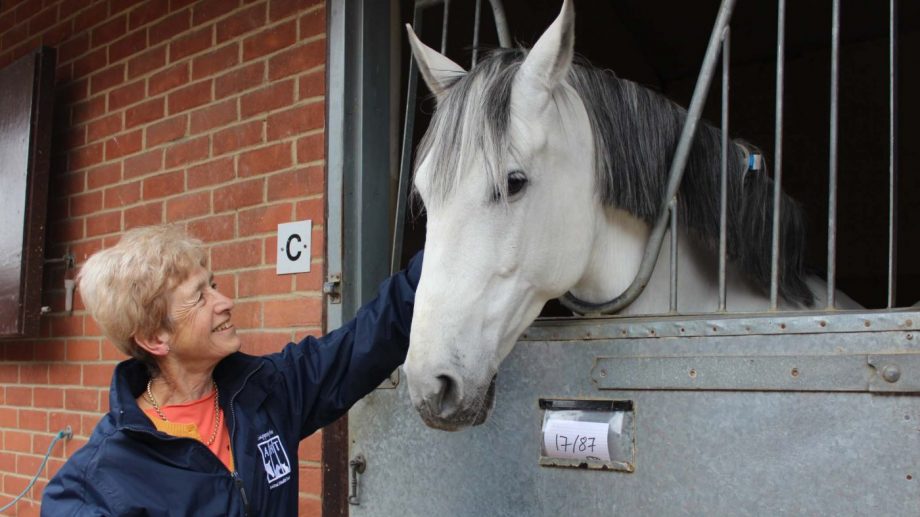A study looking into the behaviours of a group of 60 ridden horses, considered sound by their owners, identified that 73% had low-grade lameness in one or more legs, using Dr Sue Dyson’s ridden horse pain ethogram. H&H finds out more about the research and its implications for the future...
More education is needed to better understand how horse behaviour can reflect underlying pain, a study indicates.
In the research, led by veterinary orthopaedic specialist Sue Dyson, 60 sports and riding school horses, considered sound by their owners, were assessed using a ridden horse pain ethogram (RHpE). The RHpE comprises 24 behaviours more likely to be seen in lame than sound horses; the presence of eight or more of these behaviours is likely to reflect pain.
{"content":"PHA+T2YgdGhlIDYwLCA3MyUgd2VyZSBmb3VuZCB0byBiZSBzdWZmZXJpbmcgd2l0aCBsb3ctZ3JhZGUgbGFtZW5lc3Mgb24gb25lIG9yIG1vcmUgbGVncywgNDclIGhhZCBnYWl0IGFibm9ybWFsaXRpZXMgaW4gY2FudGVyLCBhbmQgNDclIGhhZCBpbGwtZml0dGluZyBzYWRkbGVzIHdpdGggcG90ZW50aWFsIHRvIGFkdmVyc2VseSBpbmZsdWVuY2UgcGVyZm9ybWFuY2UuIExhbWUgaG9yc2VzIGhhZCBoaWdoZXIgUkhwRSBzY29yZXMgdGhhbiBub24tbGFtZSBob3JzZXMuIFRoZSBzdHVkeSB3YXMgYW4gZXh0ZW5zaW9uIG9mIHByZXZpb3VzIHdvcmsgdGhhdCBoYWQgc2hvd24gdGhhdCBzcGVjaWZpYyBmYWNpYWwgZXhwcmVzc2lvbnMgYW5kIG90aGVyIGJlaGF2aW91cnMgYXJlIGEgcmVsaWFibGUgaW5kaWNhdG9yIG9mIG11c2N1bG9za2VsZXRhbCBwYWluLjwvcD4KPHA+RHIgRHlzb24gdG9sZCA8ZW0+SCZhbXA7SDwvZW0+IHdoaWxlIHNoZSBleHBlY3RlZCB0byBmaW5kIGF0IGxlYXN0IDUwJSBvZiB0aGUgaG9yc2VzIHRvIHNob3cgbGFtZW5lc3MsIGEgZmlndXJlIHByZXZpb3VzbHkgZGVtb25zdHJhdGVkIGJ5IHJlc2VhcmNoLCBzaGUgd2FzIGRpc2FwcG9pbnRlZCBieSB0aGUgbGFyZ2VyIHByb3BvcnRpb24g4oCTIGJ1dCBhZGRlZCB0aGlzIHdvcmsgcmVpbmZvcmNlZCB0aGUgdmFsdWUgb2YgdGhlIFJIcEUgYXMgYSDigJxzaWducG9zdOKAnCB0b3dhcmRzIHRoZSBwcmVzZW5jZSBvZiBwYWluLjwvcD4KPHA+4oCcQ2xlYXJseSB0aGVyZSBpcyBpZ25vcmFuY2UgYWJvdXQgdGhlIGZhY3QgYmVoYXZpb3VyIGNhbiByZWZsZWN0IHVuZGVybHlpbmcgcGFpbizigJ0gc2hlIHNhaWQuIOKAnEVkdWNhdGlvbiBpcyByZXF1aXJlZCBzbyBvd25lcnMsIHJpZGVycyBhbmQgdHJhaW5lcnMgcmVjb2duaXNlIGJlaGF2aW91ciwgc3VjaCBhcyBlYXJzIGJhY2sgYW5kIHRhaWwgc3dpc2hpbmcsIGNhbiByZWZsZWN0IG11c2N1bG9za2VsZXRhbCBwYWluLCBhbmQgdmV0cyBrbm93IGhvdyBiZXN0IHRvIGludmVzdGlnYXRlIHN1Y2ggaG9yc2VzLjwvcD4KPHA+PGRpdiBjbGFzcz0iYWQtY29udGFpbmVyIGFkLWNvbnRhaW5lci0tbW9iaWxlIj48ZGl2IGlkPSJwb3N0LWlubGluZS0yIiBjbGFzcz0iaXBjLWFkdmVydCI+PC9kaXY+PC9kaXY+PHNlY3Rpb24gaWQ9ImVtYmVkX2NvZGUtMzEiIGNsYXNzPSJoaWRkZW4tbWQgaGlkZGVuLWxnIHMtY29udGFpbmVyIHN0aWNreS1hbmNob3IgaGlkZS13aWRnZXQtdGl0bGUgd2lkZ2V0X2VtYmVkX2NvZGUgcHJlbWl1bV9pbmxpbmVfMiI+PHNlY3Rpb24gY2xhc3M9InMtY29udGFpbmVyIGxpc3RpbmctLXNpbmdsZSBsaXN0aW5nLS1zaW5nbGUtc2hhcmV0aHJvdWdoIGltYWdlLWFzcGVjdC1sYW5kc2NhcGUgZGVmYXVsdCBzaGFyZXRocm91Z2gtYWQgc2hhcmV0aHJvdWdoLWFkLWhpZGRlbiI+DQogIDxkaXYgY2xhc3M9InMtY29udGFpbmVyX19pbm5lciI+DQogICAgPHVsPg0KICAgICAgPGxpIGlkPSJuYXRpdmUtY29udGVudC1tb2JpbGUiIGNsYXNzPSJsaXN0aW5nLWl0ZW0iPg0KICAgICAgPC9saT4NCiAgICA8L3VsPg0KICA8L2Rpdj4NCjwvc2VjdGlvbj48L3NlY3Rpb24+PC9wPgo8cD7igJxXaGVuIGFuIG93bmVyIHNheXMsIOKAmE15IGhvcnNlIGRvZXNu4oCZdCBsaWtlIGRyZXNzYWdlLOKAmSBpdCBtYXkgYmUgYmVjYXVzZSB0aGUgaG9yc2UgaXMgdW5jb21mb3J0YWJsZSwgYW5kIGlmIHRoZSB1bmRlcmx5aW5nIHByb2JsZW0gd2FzIHJlY29nbmlzZWQgYW5kIHRyZWF0ZWQsIHRoZSBob3JzZSBtYXkgYmUgYWJsZSB0byBwZXJmb3JtIGRyZXNzYWdlIHF1aXRlIHdlbGwu4oCdPC9wPgo8cD5UaGUgc3R1ZHkgZm91bmQgYSBsYXJnZXIgcHJvcG9ydGlvbiBvZiB0aGUgcmlkaW5nIHNjaG9vbCBob3JzZXMgY29tcGFyZWQgd2l0aCB0aGUgc3BvcnRzIGhvcnNlcyBzaG93ZWQgbGFtZW5lc3Mgb3IgZ2FpdCBhYm5vcm1hbGl0aWVzIGluIGNhbnRlci48L3A+CjxwPuKAnEkgdGhpbmsgYmFjayB0byB0aGUgcmlkaW5nIHNjaG9vbCB3aGVyZSBJIGdyZXcgdXAgYW5kIHJlbWVtYmVyIHRoZXJlIGJlaW5nIHNvbWUgZ3J1bXB5IG9yIG5vdCB2ZXJ5IHdpbGxpbmcgaG9yc2VzLCBhbmQgcmV0cm9zcGVjdGl2ZWx5IHRoZXkgcHJvYmFibHkgaGFkIHNvbWUgZGVncmVlIG9mIG11c2N1bG9za2VsZXRhbCBkaXNjb21mb3J0LOKAnSBzYWlkIERyIER5c29uLiDigJxIb3JzZXMgYXJlIHRyeWluZyB0byBjb21tdW5pY2F0ZTsgd2UgbmVlZCB0byBsZWFybiBob3cgdG8gbGlzdGVuLuKAnTwvcD4KPGRpdiBjbGFzcz0iYWQtY29udGFpbmVyIGFkLWNvbnRhaW5lci0tbW9iaWxlIj48ZGl2IGlkPSJwb3N0LWlubGluZS0zIiBjbGFzcz0iaXBjLWFkdmVydCI+PC9kaXY+PC9kaXY+CjxwPkx1Y3kgR3JpZXZlLCBjaGFpciBvZiB0aGUgQnJpdGlzaCBFcXVlc3RyaWFuIFZldGVyaW5hcnkgQXNzb2NpYXRpb27igJlzIGV0aGljcyBhbmQgd2VsZmFyZSBjb21taXR0ZWUgdG9sZCA8ZW0+SCZhbXA7SDwvZW0+IHRoZSBzdHVkeSBzaG93cyBzY2llbmNlIGNhbiBiZSBhcHBsaWVkIHRvIGdpdmUgcmlkZXJzLCB0cmFpbmVycyBhbmQgdmV0cyBhIGZyYW1ld29yayB0byBtb3JlIHJlbGlhYmx5IGlkZW50aWZ5IGhvcnNlcyB3aG8gbmVlZCBoZWxwIGFuZCBlbmFibGUgZWFybHkgZGV0ZWN0aW9uLjwvcD4KPHA+4oCcSG9yc2VzIGFyZSBmcmVxdWVudGx5IHByZXNlbnRlZCB0byB2ZXRzIGZhciB0b28gbGF0ZSBhZnRlciB0aGUgaW5qdXJ5IHN0YXJ0ZWQuIEVhcmx5IGRldGVjdGlvbiBub3Qgb25seSBtZWFucyB0aGUgaG9yc2Ugc2hvdWxkIHN1ZmZlciBmb3IgbGVzcyB0aW1lLCBidXQgaXQgY2FuIGtlZXAgY29zdHMgYW5kIHJlY292ZXJ5IHRpbWUgZG93bizigJ0gc2hlIHNhaWQuPC9wPgo8ZGl2IGNsYXNzPSJhZC1jb250YWluZXIgYWQtY29udGFpbmVyLS1tb2JpbGUiPjxkaXYgaWQ9InBvc3QtaW5saW5lLTQiIGNsYXNzPSJpcGMtYWR2ZXJ0Ij48L2Rpdj48L2Rpdj4KPHA+4oCcQSBob3JzZSB3aXRoIGEgbWlsZCwgc2hvcnQtbGl2ZWQgaW5qdXJ5IGlzIG11Y2ggbW9yZSBsaWtlbHkgdG8gcmV0dXJuIHRvIGZ1bGwgaGVhbHRoIHRoYW4gb25lIHdpdGggYW4gaW5qdXJ5IHRoYXQgaGFzIGdydW1ibGVkIG9uIHVubm90aWNlZCBhbmQgcG90ZW50aWFsbHkgcmVzdWx0ZWQgaW4gYSBkb21pbm8gZWZmZWN0LCBsZWFkaW5nIHRvIHRoZSBkZXZlbG9wbWVudCBvZiBmdXJ0aGVyIHNlY29uZGFyeSBpbmp1cmllcy7igJ08L3A+CjxkaXYgY2xhc3M9ImluamVjdGlvbiI+PC9kaXY+CjxwPlZldGVyaW5hcnkgYmVoYXZpb3VyIHNwZWNpYWxpc3QgR2VtbWEgUGVhcnNvbiB0b2xkIDxlbT5IJmFtcDtIPC9lbT4gdGhpcyBpcyBhbiBpbXBvcnRhbnQgc3R1ZHkgZGVtb25zdHJhdGluZyB0aGUgYXNzb2NpYXRpb24gYmV0d2VlbiBmYWNpYWwgZXhwcmVzc2lvbnMgYW5kIHBhaW4gYW5kIGxhbWVuZXNzLjwvcD4KPGRpdiBjbGFzcz0iYWQtY29udGFpbmVyIGFkLWNvbnRhaW5lci0tbW9iaWxlIj48ZGl2IGlkPSJwb3N0LWlubGluZS01IiBjbGFzcz0iaXBjLWFkdmVydCI+PC9kaXY+PC9kaXY+CjxwPuKAnE1hbnkgcGVvcGxlIGZhaWwgdG8gcmVjb2duaXNlIHN1YnRsZSBzaWducyBvZiBwYWluIG9yIHN0cmVzcyBpbiBob3JzZXMgYW5kIGFzc3VtZSBhbnkgdW53YW50ZWQgYmVoYXZpb3VycyBhcmUgZHVlIHRvIHRoZSBob3JzZSBiZWluZyBuYXVnaHR5LOKAnSBzaGUgc2FpZC48L3A+CjxwPgo="}
You may also be interested in…
Credit: Alamy Stock Photo
Dr Sue Dyson is a veterinary orthopaedic specialist.
Credit: Animal Health Trust
Research has found it is possible for untrained observers to assess pain and lameness in ridden horses using an ethogram
Dr Sue Dyson is a veterinary orthopaedic specialist.
Credit: Animal Health Trust
The latest research by Dr Sue Dyson to identify lameness through a horse’s behaviour and facial expressions has successfully completed
Do we always listen to what our horses are trying to tell us? A new study is linking facial expressions
Credit: Lara Piccolo and Kathrin Kienapfel
The aim of the video series is to improve welfare and performance in ridden horses
Stay in touch with all the news in the run-up to and throughout the major shows and events during 2025 and beyond with a Horse & Hound subscription. Subscribe today for all you need to know ahead of these major events, plus online reports on the action as it happens from our expert team of reporters and in-depth analysis in our special commemorative magazines. Have a subscription already? Set up your unlimited website access now
H&H senior news writer
Since joining H&H in 2018, Becky has covered a broad range of equestrian news including welfare matters, veterinary studies, FEI Tribunal hearings and road safety campaigns. She has also interviewed top riders including Scott Brash, John Whitaker and Ian Stark, to name just a few. Becky’s reporting has taken her to Canada for Spruce Meadows and France for Pau five-star, as well as the Royal Highland and Blair Castle International Horse Trials closer to home. She was also a key part of the remote reporting team for the Tokyo Olympics and the Europeans.






